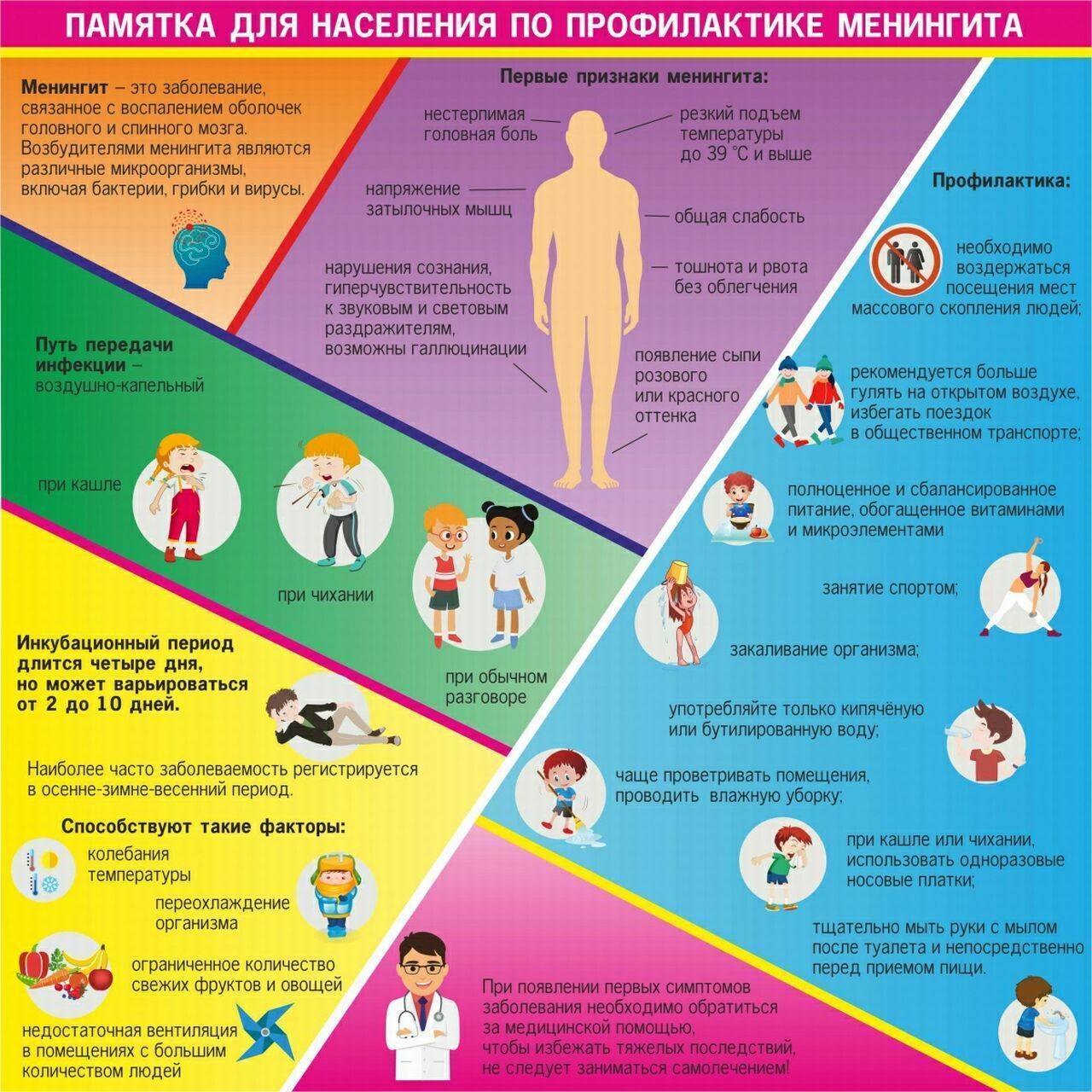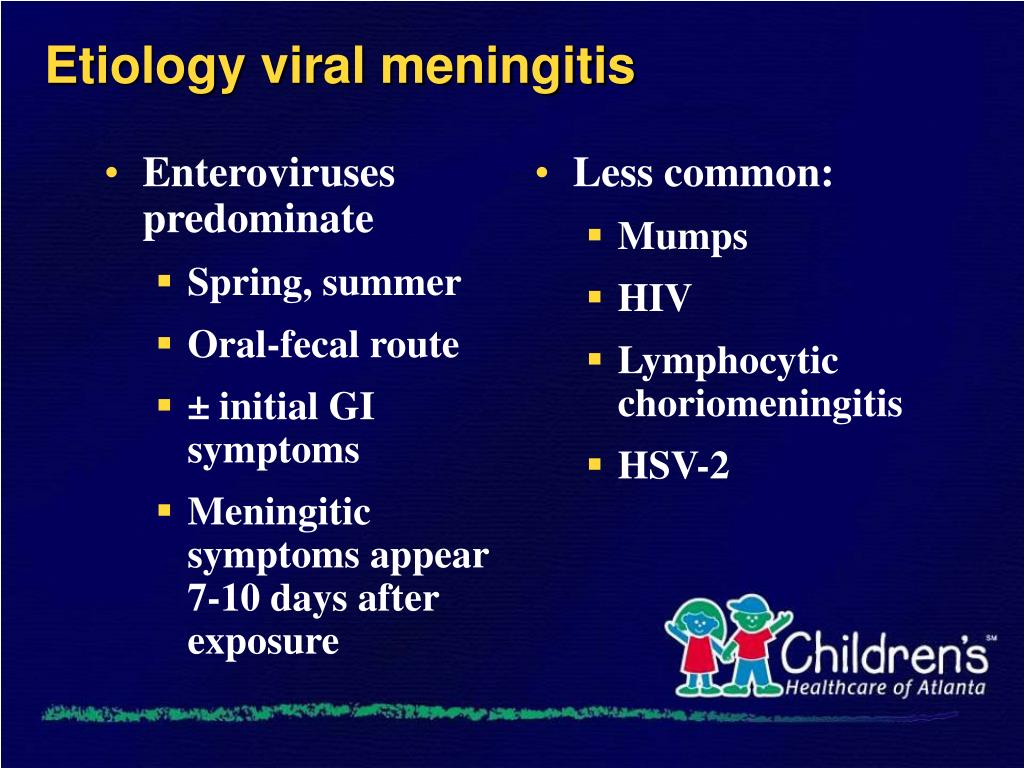Ways to check for meningitis. Meningitis Tests, Symptoms, and Diagnosis: A Comprehensive Guide
How is meningitis diagnosed. What are the key symptoms of meningitis. When should you seek medical attention for suspected meningitis. What tests are used to confirm meningitis. How do doctors differentiate between viral and bacterial meningitis.
Understanding Meningitis: A Potentially Life-Threatening Condition
Meningitis is a serious medical condition characterized by inflammation of the meninges, the protective membranes surrounding the brain and spinal cord. This inflammation can be caused by various factors, with infections being the most common culprits. Given its potential severity, prompt diagnosis and treatment are crucial for improving outcomes.
The causes of meningitis include:
- Viral infections (most common)
- Bacterial infections
- Fungal infections (less common)
- Parasitic infections (rare)
- Non-infectious causes (e.g., certain cancers or autoimmune disorders)
In rare cases, a type of amoeba called Naegleria fowleri can cause a particularly deadly form of meningitis. This organism can enter the brain through the nasal passages when contaminated water is inhaled.

Recognizing the Warning Signs: When to Seek Medical Attention
Identifying meningitis symptoms early is critical for timely intervention. While symptoms can vary, there are several red flags that warrant immediate medical attention:
- Severe, persistent headache
- Stiff neck
- High fever, especially following a recent illness
- Sensitivity to light (photophobia)
- Unexplained rash
- Seizures
- Vomiting
- Confusion or altered mental state
Can meningitis symptoms appear suddenly? Indeed, the onset of meningitis can be rapid, particularly in bacterial cases. This underscores the importance of seeking emergency medical care if these symptoms manifest, as bacterial meningitis can be life-threatening within hours.
Diagnostic Approaches: Unraveling the Mystery of Meningitis
Diagnosing meningitis involves a multi-faceted approach, combining physical examination, laboratory tests, and imaging studies when necessary. The diagnostic process typically includes:
1. Physical Examination
The initial step in diagnosing meningitis often involves a thorough physical examination. During this assessment, healthcare providers look for specific signs that may indicate meningeal inflammation:
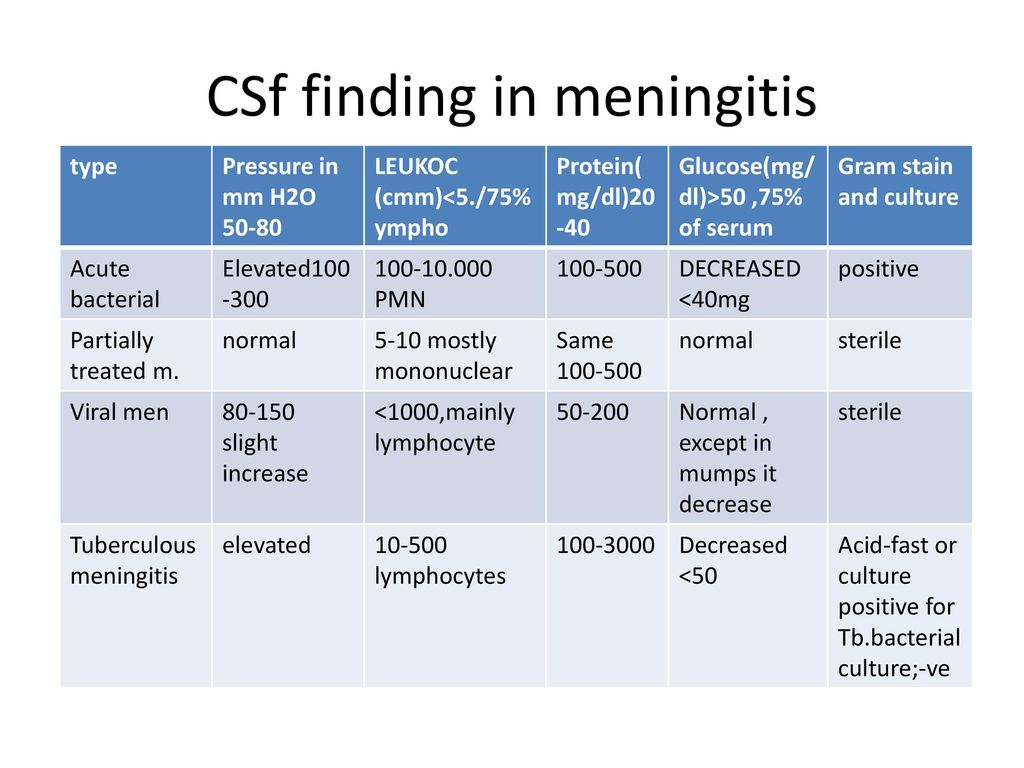
- Brudzinski’s sign: When the doctor flexes the patient’s neck, involuntary flexion of the knees and hips occurs.
- Kernig’s sign: Pain and resistance are experienced when the doctor attempts to straighten the patient’s leg while the hip is flexed.
Are these physical signs always present in meningitis cases? While these signs can be indicative of meningitis, their absence does not rule out the condition. Further testing is typically required for a definitive diagnosis.
2. Blood Tests
Blood tests play a crucial role in the diagnostic process:
- Complete blood count (CBC): Elevated white blood cell counts may indicate infection.
- Blood culture: Can detect certain bacterial or fungal pathogens in the bloodstream.
- Procalcitonin levels: Higher levels may suggest a bacterial rather than viral infection.
How accurate are blood tests in diagnosing meningitis? While blood tests provide valuable information, they are not definitive for diagnosing meningitis. According to research, blood cultures are positive in only 62-66% of adults under 60 with bacterial meningitis, and 73% in adults over 65.

3. Cerebrospinal Fluid (CSF) Analysis
The gold standard for diagnosing meningitis is the analysis of cerebrospinal fluid obtained through a lumbar puncture (spinal tap). This procedure involves inserting a needle between the vertebrae in the lower back to collect a sample of the fluid surrounding the brain and spinal cord.
CSF analysis can provide critical information:
- Cell count and type
- Glucose and protein levels
- Presence of bacteria, viruses, or other pathogens
Is a lumbar puncture always necessary to diagnose meningitis? While it is the most reliable method, in some cases, treatment may be initiated based on clinical suspicion before CSF results are available, especially if bacterial meningitis is suspected.
Differentiating Viral and Bacterial Meningitis: A Critical Distinction
Distinguishing between viral and bacterial meningitis is crucial for determining the appropriate treatment course. While both can present with similar symptoms, there are some key differences:
Viral Meningitis
- Generally less severe
- Often resolves without specific treatment
- CSF analysis typically shows elevated white blood cells with normal glucose levels
- Procalcitonin levels in blood are usually lower
Bacterial Meningitis
- More severe and potentially life-threatening
- Requires immediate antibiotic treatment
- CSF analysis often shows very high white blood cell counts and low glucose levels
- Procalcitonin levels in blood are typically higher
Can doctors always definitively determine the type of meningitis immediately? While certain indicators can suggest viral or bacterial causes, definitive identification may require additional testing, such as PCR or culture results, which can take time.
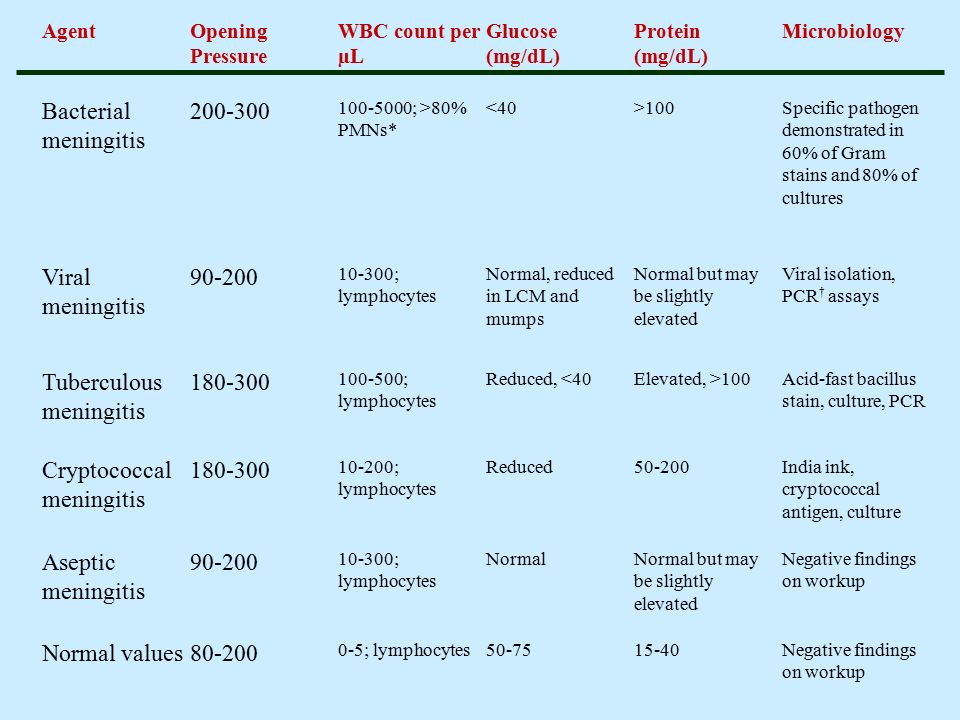
Imaging Studies: Peering Inside the Brain
In some cases, imaging studies may be used to complement other diagnostic tests or to rule out complications:
- Computed Tomography (CT) scan: Can help identify increased intracranial pressure or other structural abnormalities.
- Magnetic Resonance Imaging (MRI): Provides detailed images of the brain and can detect inflammation or other abnormalities.
Are imaging studies necessary for all suspected meningitis cases? Not always. They are typically used when there are concerns about complications or when the diagnosis is unclear based on other tests.
Treatment Approaches: Tailoring Care to the Cause
The treatment for meningitis varies depending on the underlying cause:
Bacterial Meningitis
Requires immediate antibiotic treatment, often started before the specific pathogen is identified. The choice of antibiotics may be adjusted once culture results are available.
Viral Meningitis
Generally, supportive care is the mainstay of treatment. In some cases, antiviral medications may be used if a specific viral cause is identified.

Fungal Meningitis
Treated with antifungal medications, which may need to be administered for an extended period.
Parasitic Meningitis
Treatment depends on the specific parasite involved and may include antiparasitic medications.
How long does meningitis treatment typically last? The duration of treatment can vary widely, from a few days for some viral cases to several weeks for bacterial or fungal meningitis.
Prognosis and Long-Term Outlook: Understanding the Impact
The prognosis for meningitis varies significantly depending on the cause, timely diagnosis, and appropriate treatment:
- Viral meningitis: Generally has a good prognosis, with most people recovering fully within 7-10 days.
- Bacterial meningitis: Can be life-threatening if not treated promptly. Even with treatment, it can lead to serious complications.
- Fungal meningitis: Often has a more prolonged course and may require extended treatment.
Potential long-term complications of meningitis include:
- Hearing loss
- Cognitive impairment
- Seizures
- Motor deficits
- Hydrocephalus (accumulation of fluid in the brain)
Can meningitis recur after initial treatment? While rare, recurrent meningitis can occur, particularly in individuals with certain risk factors or underlying conditions.

Prevention Strategies: Reducing the Risk of Meningitis
While not all cases of meningitis are preventable, certain measures can reduce the risk:
- Vaccination: Vaccines are available for several types of bacteria that can cause meningitis, including Neisseria meningitidis, Streptococcus pneumoniae, and Haemophilus influenzae type b.
- Good hygiene practices: Regular handwashing and avoiding close contact with individuals who have respiratory infections can help prevent the spread of pathogens.
- Avoiding high-risk behaviors: Certain activities, such as sharing utensils or engaging in unprotected sexual contact, can increase the risk of exposure to meningitis-causing pathogens.
Are meningitis vaccines 100% effective? While highly effective, no vaccine provides complete protection. However, vaccination significantly reduces the risk of contracting vaccine-preventable forms of meningitis.
Meningitis remains a significant health concern due to its potential severity and rapid onset. Understanding the symptoms, diagnostic processes, and treatment approaches is crucial for both healthcare providers and the general public. By recognizing the warning signs and seeking prompt medical attention, the chances of successful treatment and recovery can be significantly improved. Ongoing research continues to enhance our understanding of this condition, paving the way for more effective diagnostic tools and treatment strategies in the future.
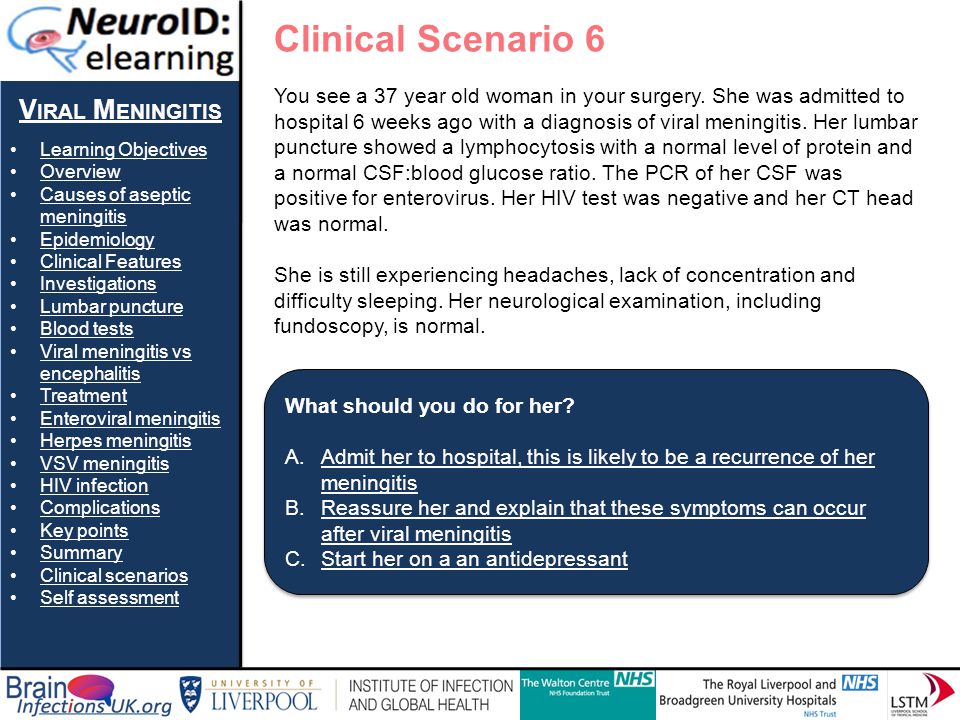
Meningitis: Tests, symptoms, diagnosis
Meningitis occurs when the meninges, the protective coating around the brain and spinal cord, becomes inflamed. Because meningitis can be a life-threatening emergency, a person who thinks they may have meningitis should seek immediate medical care.
A meningitis test can diagnose meningitis, and help determine what caused it.
A cerebrospinal fluid (CSF) analysis can definitively diagnose meningitis. However, a doctor may recommend additional tests to rule out other causes.
If a doctor suspects bacterial meningitis, they may begin antibiotic treatment before meningitis test results come back.
Meningitis causes swelling and inflammation of the meninges. The meninges are three membranes that protect the brain and spinal cord.
Meningitis usually happens when an infection – often a virus or bacteria – travels to the meninges.
Less commonly, a fungus or parasite can cause meningitis. Bacterial meningitis can kill a person within a few hours without treatment, while viral meningitis often goes away on its own.
Very rarely, an amoeba called Naegleria fowlerican travel through water, up the nose, and into the brain. This type of meningitis is almost always fatal.
Meningitis can also occur without an infection, as a result of cancer or other diseases. Meningitis tests can tell a doctor which type of meningitis a person has, and guide treatment decisions.
This article explores the importance of seeking immediate medical attention to test for meningitis, types of tests and how doctors diagnose meningitis, meningitis causes, and the outlook for a person diagnosed with various types of the disease.
Meningitis can be a life-threatening emergency, especially if a person has bacterial meningitis. Bacterial meningitis can kill a person in a few hours.
Outcomes for viral meningitis are usually better, and a person may recover on their own without treatment.
However, it is impossible to know which type of meningitis a person has without medical testing.
Though meningitis is very serious, prompt care can save lives.
Go to the emergency room or call a doctor immediately if a person has:
- a stiff neck
- a very intense headache
- a high fever, especially following an illness such as the flu
- sensitivity to light
- an unexplained rash
- seizures
- vomiting
- confusion
There are a number of different tests a doctor can perform to diagnose meningitis, depending on which type of meningitis they think a person may have. They include:
Physical examination
Meningitis testing usually begins with a physical exam, during which a doctor assesses how likely it is that a person has meningitis. A doctor may ask about any recent illnesses, all symptoms, and when any symptoms appeared.
A doctor may also perform physical tests to assess for inflammation of the meninges. Two specific tests are often used to help diagnose meningitis.
One test looks for what is known as the Brudzinski sign. During this test, a person lies on their back while a doctor flexes their neck upward and toward the chest. If this causes the person to flex their knees or hips, this suggests inflammation of the meninges, and may mean a person has meningitis.
During this test, a person lies on their back while a doctor flexes their neck upward and toward the chest. If this causes the person to flex their knees or hips, this suggests inflammation of the meninges, and may mean a person has meningitis.
The other test looks for what is called the Kernig sign. During this test, a person lies on their back. A doctor bends the knee toward the chest, then attempts to straighten the leg upward. If this is very painful or impossible, a person may have swelling in the meninges, suggesting meningitis.
Blood tests and culture
Meningitis testing also generally includes blood work, which can rule out some other potential causes of meningitis, such as sepsis.
Some blood test results, such as a very high white blood cell count, may help with diagnosing a severe infection, including meningitis.
A doctor may also order bloodwork to test for other issues, such as poisoning or dangerous changes in blood glucose.
High levels of the chemical procalcitonin can also help a doctor determine whether an infection is more likely to be viral or bacterial.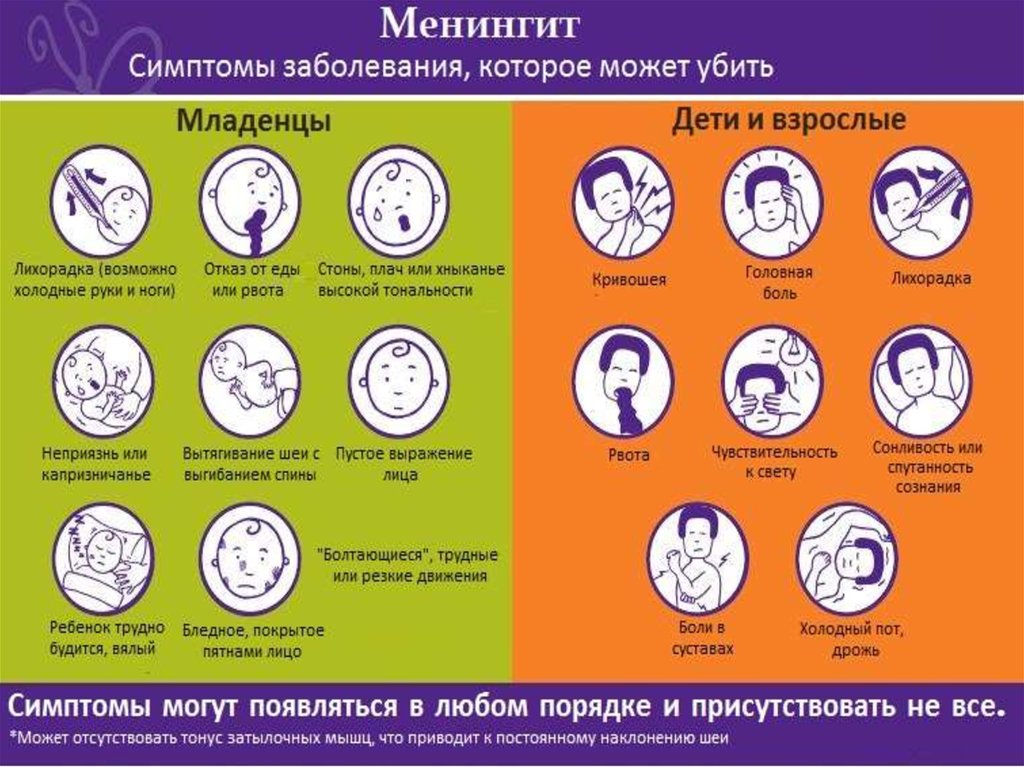 High procalcitonin suggests a bacterial infection.
High procalcitonin suggests a bacterial infection.
A blood culture, which tests the blood for certain organisms, may be able to detect some types of meningitis in the blood, including some forms of bacterial and fungal meningitis. This can help guide treatment, especially when a doctor needs to know which type of antibiotic to use for bacterial meningitis.
However, a blood culture cannot definitively diagnose or rule out meningitis. According to a 2017 American Family Physician article, just 62–66% of adults under 60 with bacterial meningitis had a positive culture. Among adults over 65, the figure was slightly higher, at 73%.
Cerebrospinal fluid test
The most reliable way to diagnose meningitis is with a lumbar puncture. During a lumbar puncture, a doctor inserts a long, thin needle in between two vertebrae in the lower back. This allows them to withdraw some cerebrospinal fluid (CSF), which is the fluid that cushions the brain and spinal cord.
The doctor then sends the CSF to the lab to analyze it for signs of infection. A CSF culture can usually detect the specific organisms causing meningitis.
A CSF culture can usually detect the specific organisms causing meningitis.
When a person has viral or noninfectious meningitis, there are not usually organisms in the CSF. Instead, a doctor will look for slightly elevated protein levels and elevated white blood cell counts.
Imaging tests
For some people, a lumbar puncture may not be safe. This may include those with high pressure inside the skull, certain brain diseases, a history of stroke, and those with weak immune systems because of HIV or certain drugs.
A CT scan uses x-rays to take pictures of the brain and skull. This can help with detecting whether there is any increased pressure in the head that may make a lumbar puncture unsafe. A doctor may recommend proceeding to a lumbar puncture if the CT scan indicates it would be safe.
A CT scan, however, is not a fully reliable measure of pressure in the head. A doctor may recommend foregoing both the CT scan and the lumbar puncture and beginning treatment if there are other signs of meningitis.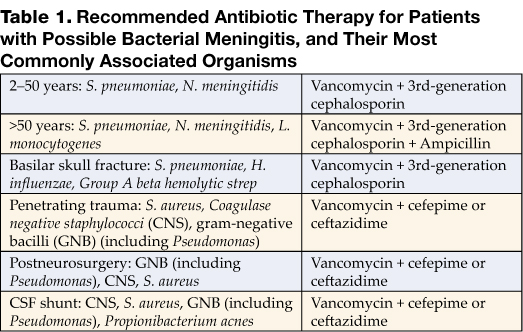
At-home tests
No home tests can conclusively prove that a person does or does not have meningitis. Instead, anyone with symptoms of meningitis should seek immediate medical care. Some warning signs include:
- a stiff neck
- a very intense headache
- a high fever, especially following an illness such as the flu
- sensitivity to light
- an unexplained rash
- seizures
- vomiting
- confusion
Looking for Kernig or Brudzinski signs may provide evidence that a person has meningitis. However, it is easy to perform these tests incorrectly, especially without medical training.
Many different infections and diseases can cause meningitis. They include:
- Viral meningitis: Viral meningitis happens when a virus, such as measles, mumps, or the flu, spreads to the meninges. Symptoms usually are less serious than other types of meningitis. Viruses that cause viral meningitis spread from one person to another.

- Bacterial meningitis: Bacterial meningitis happens when a bacterial infection spreads to the meninges. Many organisms can cause this infection, but some common culprits include group B streptococcus and Haemophilus influenzae. A person can spread group B strep to a newborn when giving birth vaginally. The infections that cause bacterial meningitis can spread from one person to another.
- Fungal meningitis: Fungal meningitis happens when a person contracts a fungal infection, often by inhaling spores from the environment. The infection can then spread to the meninges. Candida, a common fungal infection on the skin that can cause yeast infections or thrush, may also spread to the meninges, but this is rare.
- Parasitic meningitis: Parasitic meningitis happens when a parasite gets into the meninges. This is uncommon but can happen when a person eats raw or contaminated food, or has contact with raccoon feces from soil.

- Amebic meningitis: This rare and highly lethal type of meningitis happens when a bacteria that lives in the water travels up the nose to the meninges.
- Non-infectious meningitis: This means that the meninges become swollen without an infection. This can happen when a person has a serious disease like lupus erythematosus, a head injury, a recent brain surgery, or cancer.
The outlook depends on the type of meningitis a person has.
Bacterial meningitis has a much higher fatality rate than viral meningitis. In 2010, overall, 14.3% of people with bacterial meningitis died. Factors such as age – being either very young or very old – and having a weak immune system can increase the risk of death.
Amebic meningitis has a death rate that is much higher. Of 34 infections reported to Centers for Disease Control and Prevention (CDC) between 2009 and 2019, just 3 people survived.
Among people who do survive meningitis, complications are common, especially when meningitis damages the neurological system.
A 2010 meta-analysis of children diagnosed with meningitis found the following complication rates after hospital discharge:
- hearing loss: 6%
- behavioral issues: 2.6%
- cognitive challenges: 2.2%
- motor skill problems: 2.3%
- seizures: 1.6%
- vision impairments: 0.9%
Early testing and prompt treatment for meningitis is critical to survival.
A person who thinks they might have meningitis should not delay care, and should be clear and specific at the emergency room about what symptoms they are experiencing.
A person should tell a doctor about any recent potential meningitis exposures, and request testing for meningitis immediately.
Neck, Physical Exam, at Home, and More
Testing for meningitis can include various tests, including a physical exam, blood tests, bacterial cultures, and cerebrospinal fluid tests.
Meningitis happens when the membranes, or meninges, around your spinal cord and brain become swollen from inflammation.
Four types of meningitis are possible:
- Bacterial: The most severe and life-threatening form of meningitis. This type can be fatal if it’s not treated immediately with antibiotics to prevent the spread of the infection and further complications.
- Viral (aseptic): The most common cause of a meningitis infection. This type usually isn’t as serious as bacterial meningitis and often goes away without requiring treatment.
- Fungal: This uncommon type is caused by a fungus that gets into your spinal cord from your bloodstream.
- Parasitic: This much less common form of meningitis is caused by parasites.
You don’t always need treatment for nonbacterial meningitis. The infection may clear up on its own. Meningitis can be mistaken for the flu, dehydration, or gastroenteritis. It can also be overlooked because symptoms may be mild or not always apparent.
Seek emergency medical attention if you notice any symptoms of meningitis. You should also contact your doctor if someone close to you at home or work has been diagnosed. Watch out for these symptoms:
You should also contact your doctor if someone close to you at home or work has been diagnosed. Watch out for these symptoms:
- having severe neck stiffness with no apparent cause
- experiencing a constant, painful headache
- feeling disoriented
- feeling sick and throwing up
- running a high fever (101°F and higher), particularly with the above symptoms
Early treatment, within 2 to 3 days (less than 1 day is recommended), can help prevent long-term or severe complications. Bacterial meningitis can quickly become deadly or cause brain damage in a few days without antibiotics.
Your doctor will conduct a full physical examination as the first step in looking for signs of meningitis.
First, your doctor will ask you about your symptoms, your medical history, and whether you’ve been on any recent trips to regions with a higher rate of certain types of meningitis.
Then, your doctor will check your entire body for any unusual markings, signs, or lumps.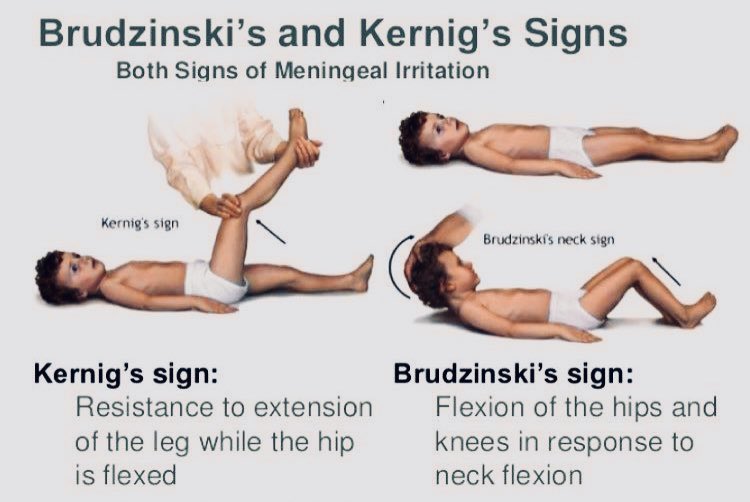 A purplish or reddish skin rash that doesn’t get lighter or disappear when you press against it can be a sign of severe infection with one of the types of bacteria that causes meningitis.
A purplish or reddish skin rash that doesn’t get lighter or disappear when you press against it can be a sign of severe infection with one of the types of bacteria that causes meningitis.
Your doctor may also look for two specific signs of a meningitis infection:
- Brudzinski’s sign: Your doctor will pull your neck forward slowly. Neck stiffness and involuntary bending of the knees and hips can indicate meningitis.
- Kernig’s sign: Your doctor will flex your leg at the knee and bend the leg forward at the hip. Then, they’ll slowly straighten your leg. Intense pain in your back or thigh can indicate meningitis. Your doctor may repeat this test on both legs.
However, more recent research shows that many people with meningitis doesn’t display these signs. A negative result on either of these tests doesn’t rule out the possibility of meningitis.
To take a bacterial culture, your doctor will collect a blood sample through a needle in a vein in your arm. The blood is transferred to small dishes known as petri dishes. Bacteria or other microorganisms can grow and become more abundant in these nutrient-rich dishes.
The blood is transferred to small dishes known as petri dishes. Bacteria or other microorganisms can grow and become more abundant in these nutrient-rich dishes.
After a certain period of time (usually a few days), your doctor can look at the bacteria through a microscope and diagnose the specific bacteria causing an infection in the blood.
Your doctor can also put a sample on a microscope slide and stain it so that the bacteria are easier to see under a microscope. The results of this test may come back earlier than those from a culture.
To do a blood test for signs of meningitis, a technician inserts a needle into a vein in your arm and draws out a sample of your blood to send to a lab for testing.
A complete blood count (CBC) or total protein count check for heightened levels of certain cells and proteins that can suggest a meningitis infection.
A procalcitonin blood test can also help your doctor tell if an infection is more likely caused by either bacteria or a virus.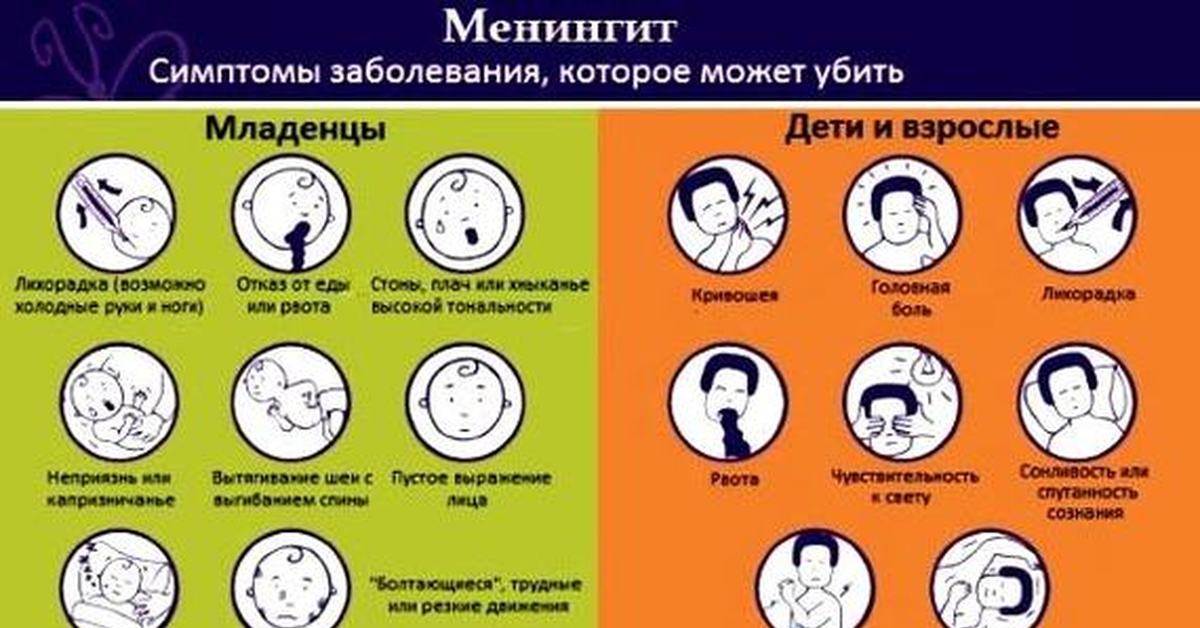
Blood tests may also be done at the same time as a spinal tap to compare the levels of cells, antibodies, and proteins and confirm the diagnosis.
An imaging test, such as computerized tomography (CT) scan, allows your doctor to take detailed images of your head and chest to look for signs of brain and spine inflammation associated with meningitis and help confirm a diagnosis.
A CT scan, in addition to magnetic resonance imaging (MRI) and X-ray imaging tests, can also help your doctor notice other things that can cause severe symptoms of meningitis, such as:
- internal bleeding (hemorrhage)
- fluid buildup in tissue (abscess)
- swelling of the brain
These conditions may make it dangerous or impossible for your doctor to perform a spinal tap, so imaging tests are typically done before your doctor decides whether to do a spinal tap.
This is the only test that can truly diagnose meningitis. To perform this test, your doctor inserts a needle into your spine in order to collect cerebrospinal fluid (CSF) that’s found around your brain and spinal cord.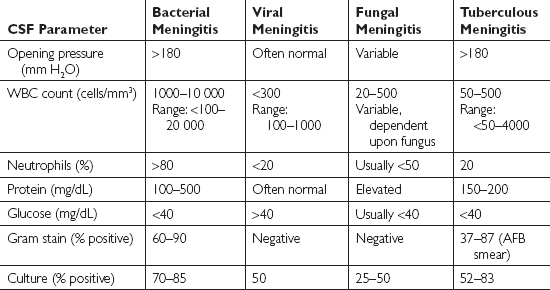 Then, your doctor sends your CSF to a lab for testing. Meningitis is often confirmed when your CSF fluid has:
Then, your doctor sends your CSF to a lab for testing. Meningitis is often confirmed when your CSF fluid has:
- low levels of sugar (glucose)
- high levels of white blood cells
- high levels of blood protein
- heightened level of antibodies responding to infection
A CSF test can also help your doctor figure out what type of bacteria or virus caused your meningitis.
Your doctor may also request a polymerase chain reaction (PCR) test. This test can analyze your CSF fluid for antibodies that increase in number during viral infections to decide what treatment will work best.
In theory, it’s possible to do the Brudzinski and Kernig tests at home to check for meningitis. However, you should still see your doctor for a diagnosis. These tests need to be performed by a professional — and even then they aren’t reliable as a sole method of diagnosis.
Remember that meningitis can be dangerous. Even if you could diagnose it at home, you wouldn’t be able to determine which type you have, and some types are life-threatening.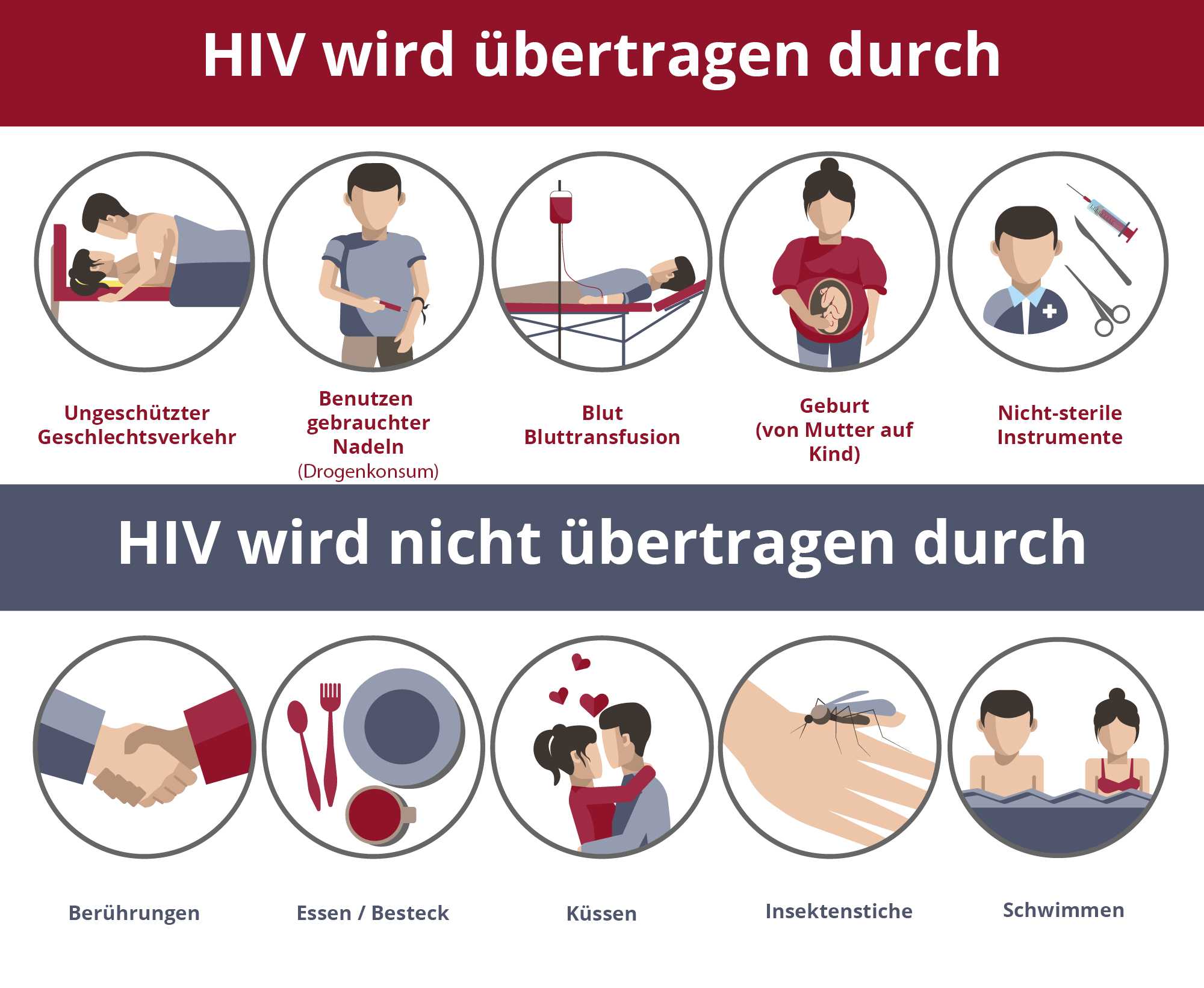 Get emergency medical help if you have these symptoms:
Get emergency medical help if you have these symptoms:
- neck stiffness
- constant, painful headache
- feelings of disorientation
- vomiting or nausea
- high fever (101°F and higher)
Here’s how to do the Brudzinski test at home:
- Lie flat on your back.
- Gently and slowly push on the back of your neck so that your head moves forward. For better results, have someone do this for you.
- Note if your hips and knees flex involuntarily as you raise your head. This is a positive Brudzinski sign, meaning that you may have meningitis.
And the Kernig test:
- Lie flat on your back.
- Lift your leg up at the hip and bend your knee to a 90-degree angle.
- Gently and slowly lift your leg up at the knee.
- Note if your back or thigh starts to hurt. This is a positive Kernig sign, meaning that you may have meningitis.
Always see your doctor for a diagnosis.
The different types of meningitis have different causes:
- Bacterial meningitis happens when bacteria pass through your blood into the CSF.
 Bacteria can also get into your meninges and infect them directly. Bacteria can be spread through infected blood.
Bacteria can also get into your meninges and infect them directly. Bacteria can be spread through infected blood. - Viral (aseptic) meningitis happens when a virus gets into your CSF from your bloodstream. This can be caused by many types of viruses, such as the herpes virus, HIV, West Nile virus, and enteroviruses.
- Fungal meningitis happens when a fungus, such as Cryptococcus, gets into your meninges or CSF from your bloodstream. It’s most common in people who have weak or compromised immune systems from cancer or HIV.
- Parasitic meningitis happens when a parasite gets into your meninges or CSF from the bloodstream. It’s often caused by eating or drinking something that’s been contaminated by an infectious parasite that normally only infects animals.
Bacterial meningitis needs to be treated right away or it may result in severe complications, such as brain damage, or become deadly.
Seek emergency medical attention if you think you have a bacterial meningitis infection. Early and effective treatment can save your life and reduce your chance of complications.
Early and effective treatment can save your life and reduce your chance of complications.
Other causes may go away after a few days without treatment. See your doctor as soon as you can if you suspect that you have a meningitis infection caused by a virus or parasite.
How to recognize meningitis and diagnose the disease in the Optimum medical laboratory in Sochi (Adler)
- Home
- How to recognize the disease
- Diseases of the nervous system
- Meningitis
More about the doctor
Symptoms, diagnosis and prevention of meningitis
Meningitis is an inflammation of the membranes of the brain or spinal cord, which can be triggered by infections of viral and bacterial etiology. Pathology is accompanied by a severe headache, a typical body position in bed, hemorrhagic rashes on the skin and stiffness of the muscles of the occipital zone. Children and adolescents, as well as elderly people with a weakened immune system, are especially susceptible to this disease.
Children and adolescents, as well as elderly people with a weakened immune system, are especially susceptible to this disease.
Causes of meningitis
The main cause of meningitis are infections of viral and bacterial etiology. The causative agent of the inflammatory process can be:
- pneumococci;
- Haemophilus influenzae;
- Escherichia coli;
- streptococci;
- amoeba.
In childhood, the main cause of the development of pathology is enteroviruses that enter the body by airborne droplets. Infection can occur during childbirth, through contaminated food, dirty water, and insect bites. The main causes of non-infectious meningitis are trauma and damage to the skull, as well as tumor processes occurring in the brain.
Mechanism of development
For the development of pathology, the pathogen must penetrate the cranial cavity and provoke an inflammatory process in the brain. In some cases, this is observed when foci of infection occur in tissues located near the meninges. Pathologies such as purulent otitis media or sinusitis can provoke meningitis.
In some cases, this is observed when foci of infection occur in tissues located near the meninges. Pathologies such as purulent otitis media or sinusitis can provoke meningitis.
In some cases, craniocerebral trauma becomes a provoking factor in the development of pathology, but the infection mainly penetrates into the cranial cavity along with the blood flow. The very process of entering the pathogen into the blood and its further spread to the meninges is associated with a poor state of immunity.
Symptoms
Meningitis causes the following clinical picture:
- rise in body temperature;
- photophobia;
- muscle tension in the occipital region;
- confusion;
- convulsive syndrome;
- strabismus;
- muscle pain syndrome;
- mental disorders;
- tachycardia;
- rashes on the skin.
If these symptoms develop, seek medical attention as soon as possible because meningitis has a high mortality rate.
Diagnostic methods
The main method for diagnosing meningitis is lumbar puncture with further examination of cerebrospinal fluid. This diagnostic method is used in all cases when there is a suspicion of a disease.
In addition, the doctor analyzes the patient’s complaints and collects an anamnesis, as well as conducts a neurological examination. With the help of a blood test, it is possible to diagnose signs of inflammation, and PCR of blood and cerebrospinal fluid helps to identify the pathogen.
Computed and magnetic resonance imaging allows to assess the structure of the brain and diagnose indirect manifestations of the pathological process in the meninges of the brain.
Prevention
Some forms of meningitis can be prevented by vaccination, which is effective for several years. As a preventive measure, it is recommended to treat chronic and acute pathologies of an infectious nature in a timely manner and take courses of immunostimulating drugs in the foci of meningococcal disease. In addition, you should harden the body, avoid visiting places with large crowds of people and severe hypothermia. In the autumn-winter period, you need to drink multivitamin complexes or vitamin C.
In addition, you should harden the body, avoid visiting places with large crowds of people and severe hypothermia. In the autumn-winter period, you need to drink multivitamin complexes or vitamin C.
Tests for meningococcal infection
The causative agent of meningococcal infection is Neisseria meningitidis (meningococcus). Meningococcus colonizes the posterior wall of the human nasopharynx and, depending on the virulence of the strain and the resistance of the infected person, causes an infectious process with a wide range of clinical manifestations: asymptomatic carriage, nasopharyngitis and a generalized form – meningococcemia and / or meningitis. Meningococcal infection affects people of all ages, but more often (70%) children get sick. The lethality rate averages 10%, which determines the high social significance of the disease. Capsular strains of meningococcus, depending on the chemical structure of the capsular polysaccharide, are divided into a number of serological groups: A, B, C, X, Y, Z, W-135, 29-E, H, I, K, L. More than 90% of cases of generalized forms of meningococcal infection are caused by strains of serogroups A, B and C, much less often by strains of serogroups X, Y and W-135, the remaining serogroups are not of epidemiological interest. The determination of the serogroup is the most important procedure for the selection of an adequate vaccine preparation. All meningococci express on their surface one of the allelic variants of class 2 or 3 outer membrane proteins (PorB). Most meningococci express class 1 proteins (PorA). The antigenic structure of the PorB protein determines the serotype of the strain, while the PorA protein determines the serosubtype. Based on the chemical structure of the capsular lipopolysaccharide, the immunotype is determined. The antigenic characteristic may include some other AGs: Ora and Ors (class 5 outer membrane proteins), pili, FetA surface protein.
More than 90% of cases of generalized forms of meningococcal infection are caused by strains of serogroups A, B and C, much less often by strains of serogroups X, Y and W-135, the remaining serogroups are not of epidemiological interest. The determination of the serogroup is the most important procedure for the selection of an adequate vaccine preparation. All meningococci express on their surface one of the allelic variants of class 2 or 3 outer membrane proteins (PorB). Most meningococci express class 1 proteins (PorA). The antigenic structure of the PorB protein determines the serotype of the strain, while the PorA protein determines the serosubtype. Based on the chemical structure of the capsular lipopolysaccharide, the immunotype is determined. The antigenic characteristic may include some other AGs: Ora and Ors (class 5 outer membrane proteins), pili, FetA surface protein.
Indications for examination
- Diagnostic studies are carried out in a hospital with suspected purulent meningitis and / or a generalized form of meningococcal infection;
- studies according to epidemic indications are carried out in the focus of a generalized form of meningococcal infection among those who have been in contact with the patient and have clinical manifestations of nasopharyngitis.

Study material
- Blood – microscopic examination, culture;
- CSF – microscopic examination, culture, DNA detection, AH detection;
- swabs from the oropharynx and nose – culture;
- blood serum – detection of hypertension, determination of specific antibodies
Differential diagnosis
- Causative agents of purulent meningitis of other etiologies: Streptococcus pneumonia, Haemophilus influenza, Staphylococcus aureus, etc.;
- in the study of the nasopharynx – pigmenting Neisseria subflava, Neisseria flavescens, Neisseria mucosa, Neisseria sicca, Neisseria lactamica.
Laboratory diagnosis of a generalized form of meningococcal infection includes microscopy of biological material, inoculation of biological material with further cultural and biochemical identification of the pathogen, determination of antibiotic sensitivity; detection of specific genetic fragments of meningococcus and its AG, detection of specific antibodies.
Comparative characteristics of laboratory research methods and features of interpretation of their results. Microscopy of native cerebrospinal fluid or a “thick drop” blood product (stained with an aqueous-alcoholic solution of methylene blue) on a blue background reveals morphologically clear cocci, diplococci, stained in dark blue, resembling coffee beans or bean seeds, adjacent to each other with concave sides , sometimes the capsule comes to light. Microbial cells can be located both outside and inside leukocytes. The intensity of CSF contamination by microbial cells varies considerably and depends on the stage of development of the infectious process at the time of sampling. If antibiotic treatment has been carried out, the typical microbial cell morphology is lost. The study is recommended to be carried out in the active phase of the disease (the first two days after admission to the hospital).
Inoculation of CSF and blood on nutrient media with further incubation for 24 hours at 37°C in an atmosphere with 5–10% CO2 and high humidity makes it possible to identify the characteristic tinctorial properties of the pathogen. The study is recommended to be carried out in the active phase of the disease (the first two days after admission to the hospital) before the start of intensive antibiotic therapy.
The study is recommended to be carried out in the active phase of the disease (the first two days after admission to the hospital) before the start of intensive antibiotic therapy.
When determining the saccharolytic activity, the results of sowing a pure culture on dense nutrient media with carbohydrates are taken into account. The method makes it possible to differentiate different types of Neisseria and some other types of microorganisms (Table 16). Sometimes there is variability in saccharolytic activity in different strains of the same species.
Clarification of the biochemical properties of meningococci is carried out using reagent kits for an extended study of their enzymatic and metabolic activity, which within 2 hours allows you to determine the species of the pathogen.
The determination of the serogroup of meningococci is carried out in the agglutination reaction on glass with a set of agglutinating serogroup antisera (serogroups A, B, C, X, Y, Z, W-135,29E). The reaction is carried out only with a pure culture of meningococci that has passed all stages of identification. Meningococci of serogroups A, B and C are most often the cause of generalized forms of meningococcal infection, the agglutination reaction is carried out primarily with antisera to meningococci of these serogroups. The absence of a reaction with one of the main serogroup antibodies indicates the need to continue similar studies with other specific antisera (X, Y, Z, W-135, 29e). Only if a strain of meningococcus confirmed by all tests did not show a positive result in the agglutination test with a full set of agglutinating antisera, it should be classified as a non-agglutinating strain (NA).
The reaction is carried out only with a pure culture of meningococci that has passed all stages of identification. Meningococci of serogroups A, B and C are most often the cause of generalized forms of meningococcal infection, the agglutination reaction is carried out primarily with antisera to meningococci of these serogroups. The absence of a reaction with one of the main serogroup antibodies indicates the need to continue similar studies with other specific antisera (X, Y, Z, W-135, 29e). Only if a strain of meningococcus confirmed by all tests did not show a positive result in the agglutination test with a full set of agglutinating antisera, it should be classified as a non-agglutinating strain (NA).
Latex agglutination reaction is used to detect AG in CSF and/or blood serum. The study of native cerebrospinal fluid (express method) is carried out if it contains signs of purulent inflammation and / or microscopic detection of pathogens. The use of the reaction allows in the shortest possible time (15-20 minutes) to identify specific AG of meningococci of the most common serogroups (A, B, C, Y, W-135). It is recommended to conduct a study in the active phase of the disease (the first two days after admission to the hospital).
It is recommended to conduct a study in the active phase of the disease (the first two days after admission to the hospital).
CSF and/or a fresh pure culture of Neisseria meningitidis grown on Petri dishes is used to detect pathogen DNA. Detection of specific genetic fragments of the microorganism is performed using PCR. The method has high diagnostic sensitivity and specificity, allows to detect microorganisms contained in single quantities or in a non-viable state in a clinical sample, is characterized by high reproducibility and short deadlines for performing the study (within several hours).
Indications for conducting studies to detect DNA in the diagnosis of bacterial meningitis are:
- negative results of diagnosis by other methods, especially in the case of examination of CSF samples after massive antibiotic therapy or in the late stages of the disease;
- the need for an urgent response about the etiology of the pathogen;
- Examination of material samples delivered frozen or fixed in ethanol.

Detection of specific antibodies in the blood serum in the diagnosis of meningococcal infection is carried out using RNHA. It is recommended to conduct the study twice: in the active phase of the disease (the first two days after admission to the hospital) and on the 12-14th day of the disease. The diagnosis is considered confirmed when the increase in titers of antibodies by four or more times within the specified period.
The use of RNHA for research in “paired sera” reveals the dynamics of the increase in titers of specific antibodies to meningococcus in the blood and allows you to determine whether the pathogen belongs to the most common serogroups of meningococci (A and C). The detection of AT makes it possible to conduct a retrospective laboratory diagnosis of generalized forms of meningococcal infection, since the final answer is obtained only 12-14 days after the onset of the disease. The primary research opportunities are laboratory confirmation of meningococcemia, in which the use of other methods of laboratory diagnostics, as a rule, is not very effective.



 Bacteria can also get into your meninges and infect them directly. Bacteria can be spread through infected blood.
Bacteria can also get into your meninges and infect them directly. Bacteria can be spread through infected blood.